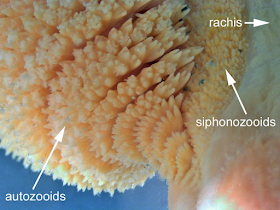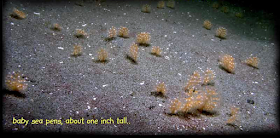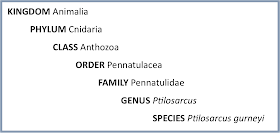 |
Ptilosarcus gurneyi (with a
striped
nudibranch) off Whidbey Island, WA;
photo by Jan Kocian.
|
Fall is right around the corner, and this month’s critter is
a preview of the brilliant colors to come. The Orange Sea Pen, also called the
Fleshy Sea Pen or Gurney’s Sea Pen, resembles a colorful autumn tree waving in
the “breeze” of moving water currents.
Family tree
Like its slender cousin Stylatula elongata, the Orange Sea Pen is actually a colony of tiny animals called polyps
Like its slender cousin Stylatula elongata, the Orange Sea Pen is actually a colony of tiny animals called polyps
 |
| A
close-up of a preserved Orange Sea Pen showing the gastrozooids (feeding polyps), siphonozooids (pumping polyps), and rachis (central stalk). |
Make like a tree and leave
The
Orange Sea Pen is surprisingly mobile, inflating its siphonozooids with water
and drifting like a leaf on the wind when it wants to relocate. It can also
deflate, partially retracting into its fleshy base when predators come calling.
The amount of retraction has been shown to be specific to the approaching
predator, which suggests that the pen can actually sense who is creeping up on
it! Unfortunately, even a retracted pen can have some soft tissue exposed, and
the sea pen’s predators are determined – and hungry.
Orange
Sea Pens make up one of the largest sources of food on the open sea floor and
are important to a wide variety of benthic predators, including sea stars like
the Leather Star, the Common Sun Star, and at least three
different nudibranch (sea slug) species.
In the limelight
Luckily
for the Orange Sea Pen, making a run for it and hunkering down aren’t its only
defenses. When the pen is physically disturbed, it can bioluminesce, producing a greenish-blue light that runs up and down
its stalk and startles predators. It can also produce a mild toxin called ptilosarcone, although the function of
this substance has not been well studied.
 |
Young Orange Sea Pens, beating the odds. Photo by Jan Kocian.
|
Branching out
The
Orange Sea Pen may not be the only species of sea pen in Puget Sound, but it is
certainly the most iconic. Its cheery form brightens up dreary sandy or muddy
sea floors in shallow subtidal waters from the Gulf of Alaska to California,
often occurring in dense beds with many pens per square meter.
Because
of the Orange Sea Pen’s tendency to occur in patches and in shallow water, we
don’t encounter them very often in our benthic grab samples, but when we do,
they are a fun and welcome sight. The adults are so easily identified that we
can count, weigh, and measure them in the field and release them alive back
into their environment!
By:
Dany Burgess & Angela Eagleston, Environmental Assessment Program
Critter of the Month
Our benthic
taxonomists, Dany and Angela, are scientists who identify and count
the benthic (sediment-dwelling) organisms in our samples as part of our Marine Sediment
Monitoring Program. We are tracking the numbers and types of species
we see in order to understand the health of Puget Sound and to detect any
changes over time.
Dany and Angela share their discoveries by
bringing us a Benthic Critter of the
Month. These posts will give you a peek into the life of Puget
Sound’s least-known inhabitants. We’ll share details on identification,
habitat, life history, and the role each critter plays in the sediment
community. Can't get enough benthos? See photos from our Eyes Under Puget
Sound collection on Flickr.



Are you aware that Ptilosarcus populations along the east shore of Central Puget Sound (Tacoma to Everett) suffered a severe decline starting in the early 1980s? Birkeland (1974) documented extensive dense populations of Ptilosarcus, but just a decade, more or less, later, most of the populations that he used in his studies were completely missing. These populations have not recovered. While Ptilosarcus is still common in South Puget Sound and obviously around Whidbey Island, the "yellow ring" around Central Puget Sound is just history.
ReplyDeleteI presented a poster, "Vacant Habitats", on this phenomenon at a Pacific Estuarine Research Society several years ago because I had worked as a volunteer research diver with Charles Birkeland in 1967-1970 studying Ptilosarcus.
By-the-way, Birkeland's studies are the only ecological work on sea pens ever published anywhere.
Cheers, Michael Kyte, Marine Biologist (semi-retired).